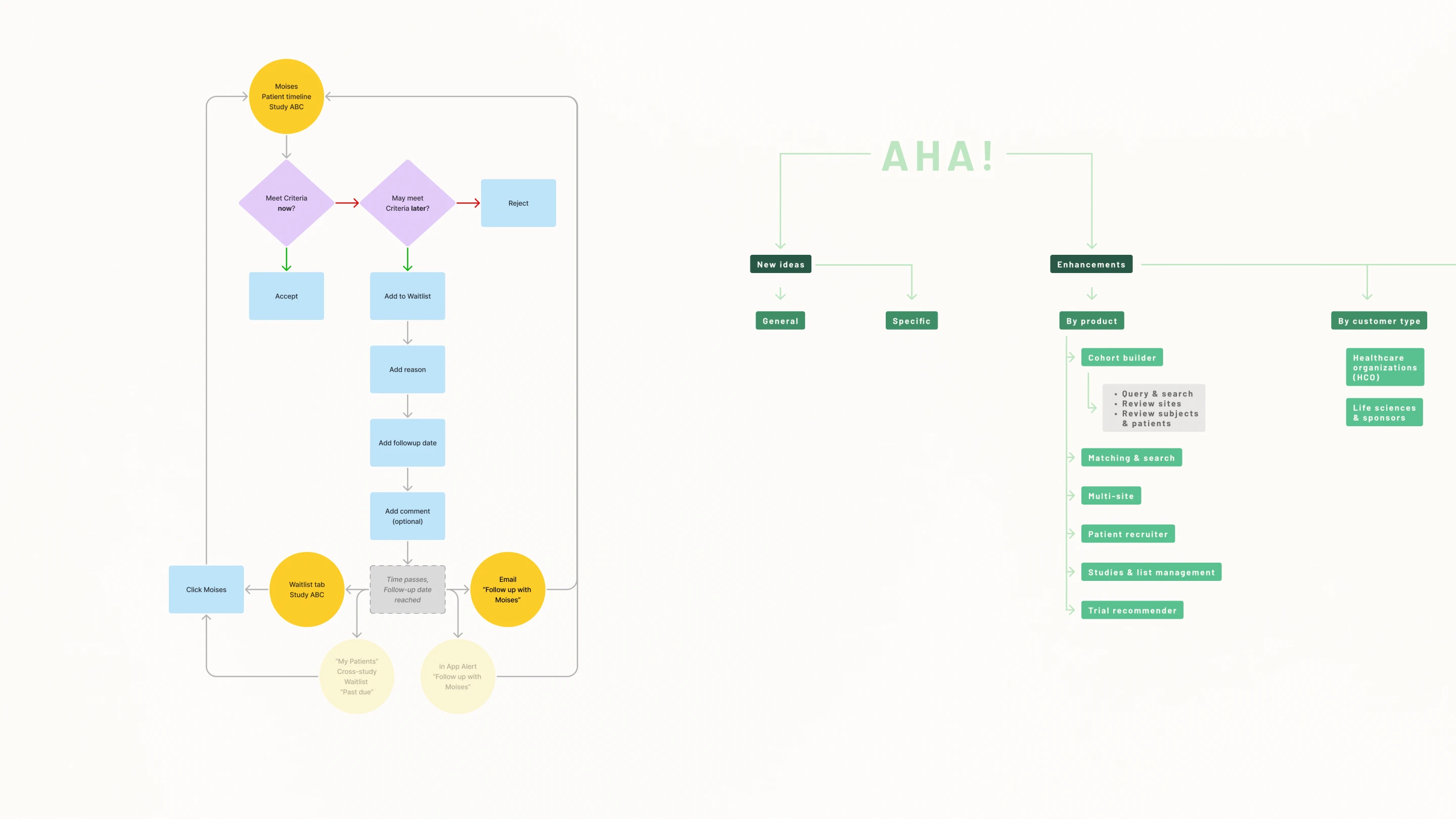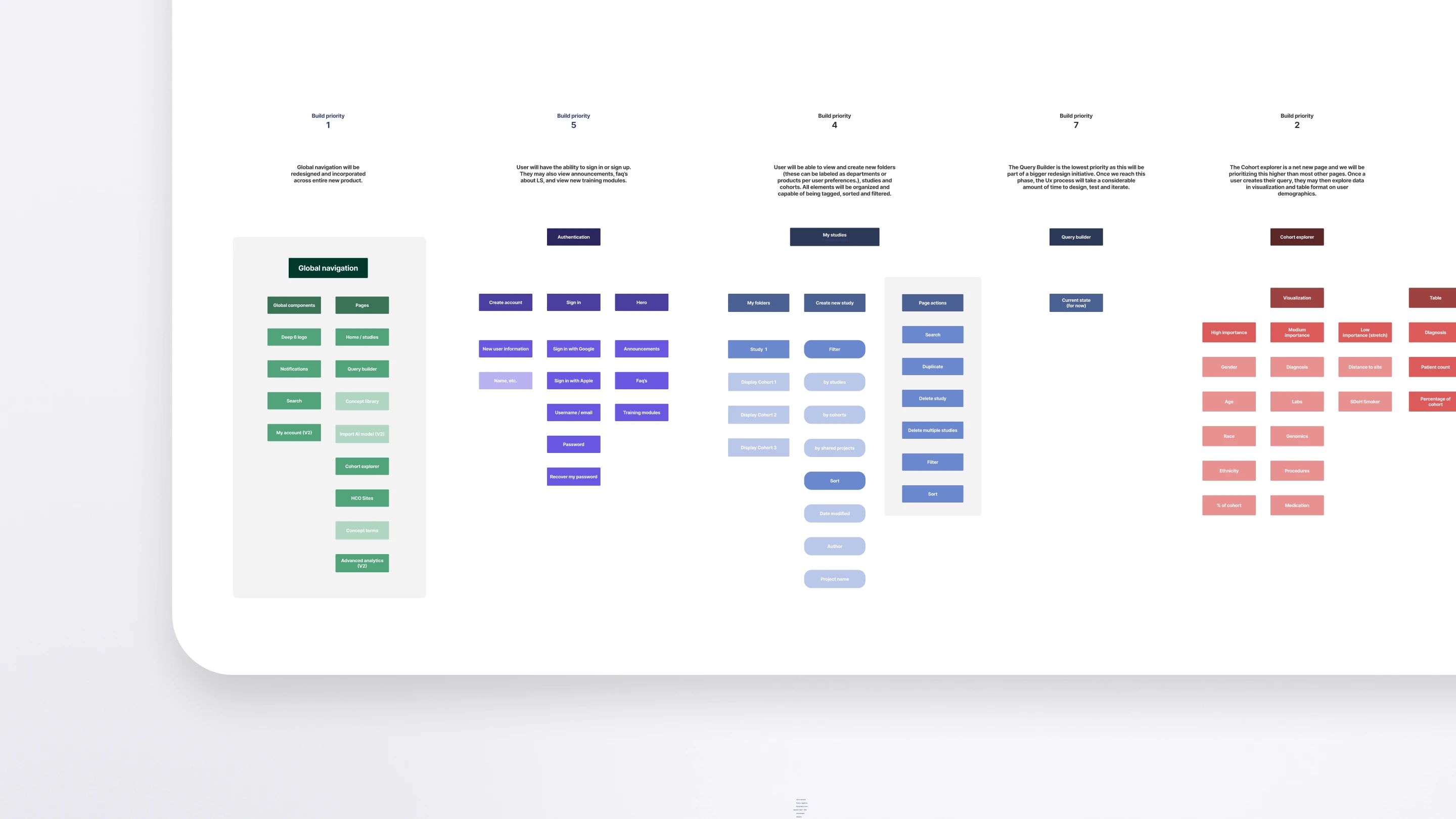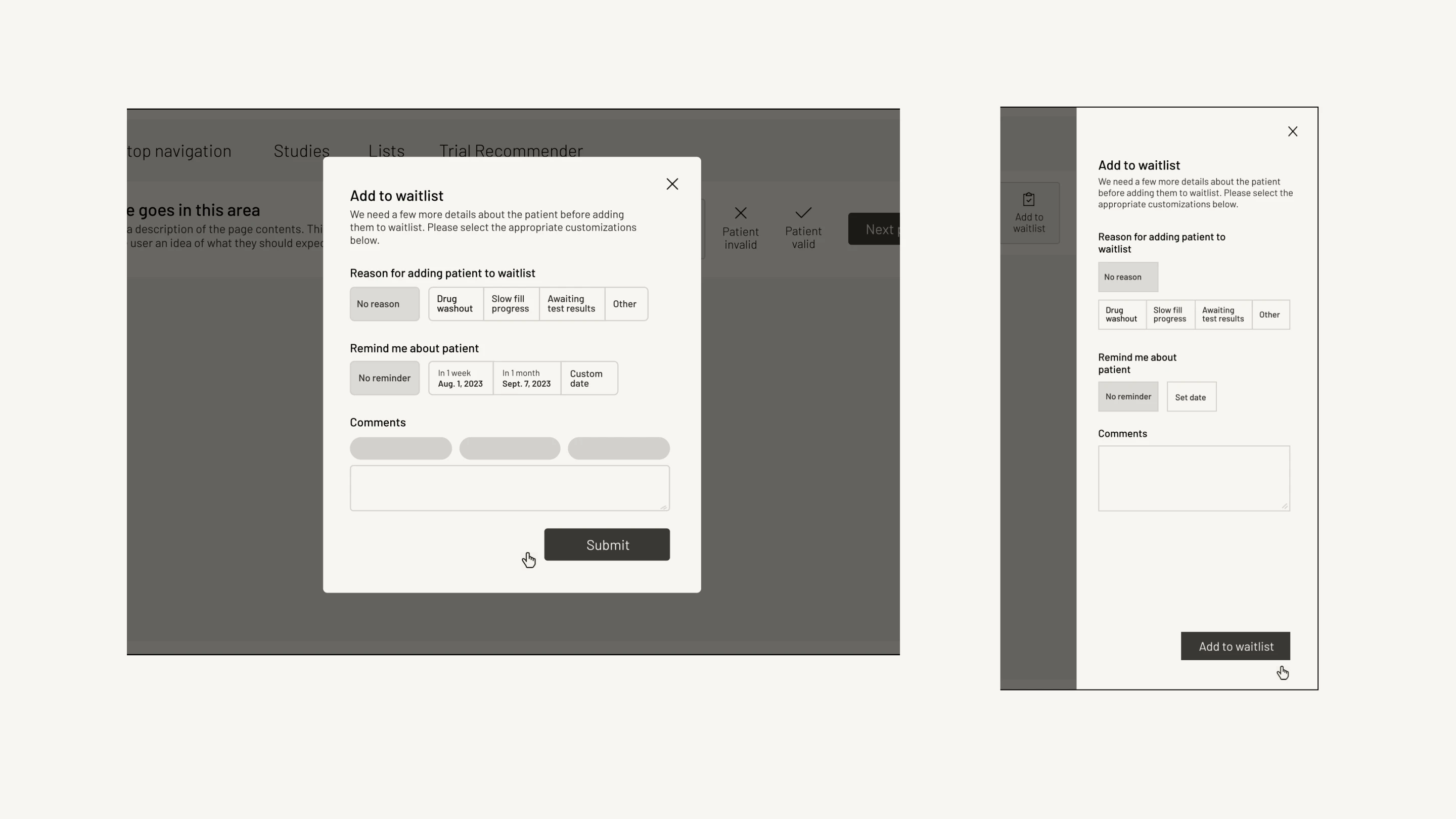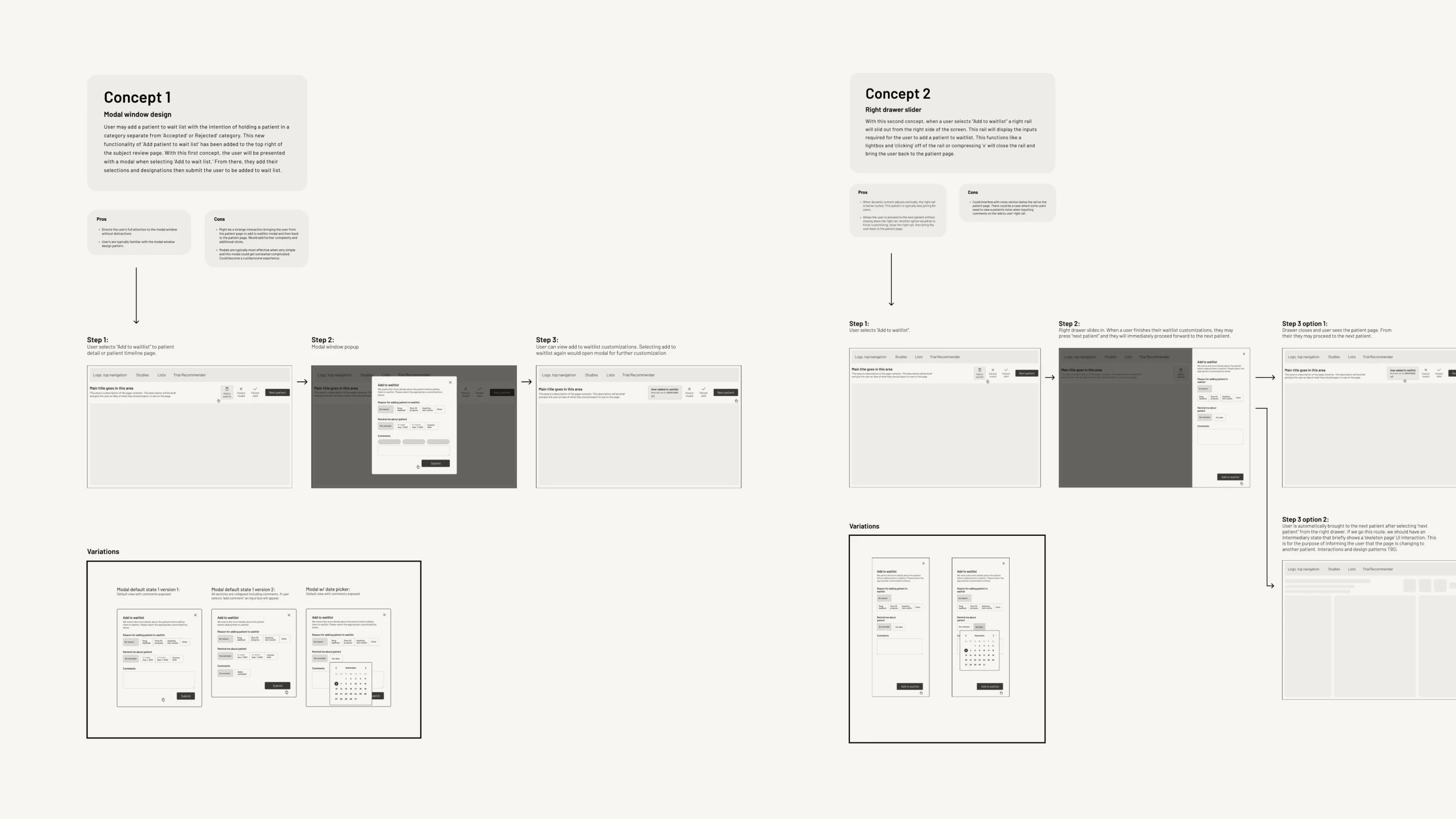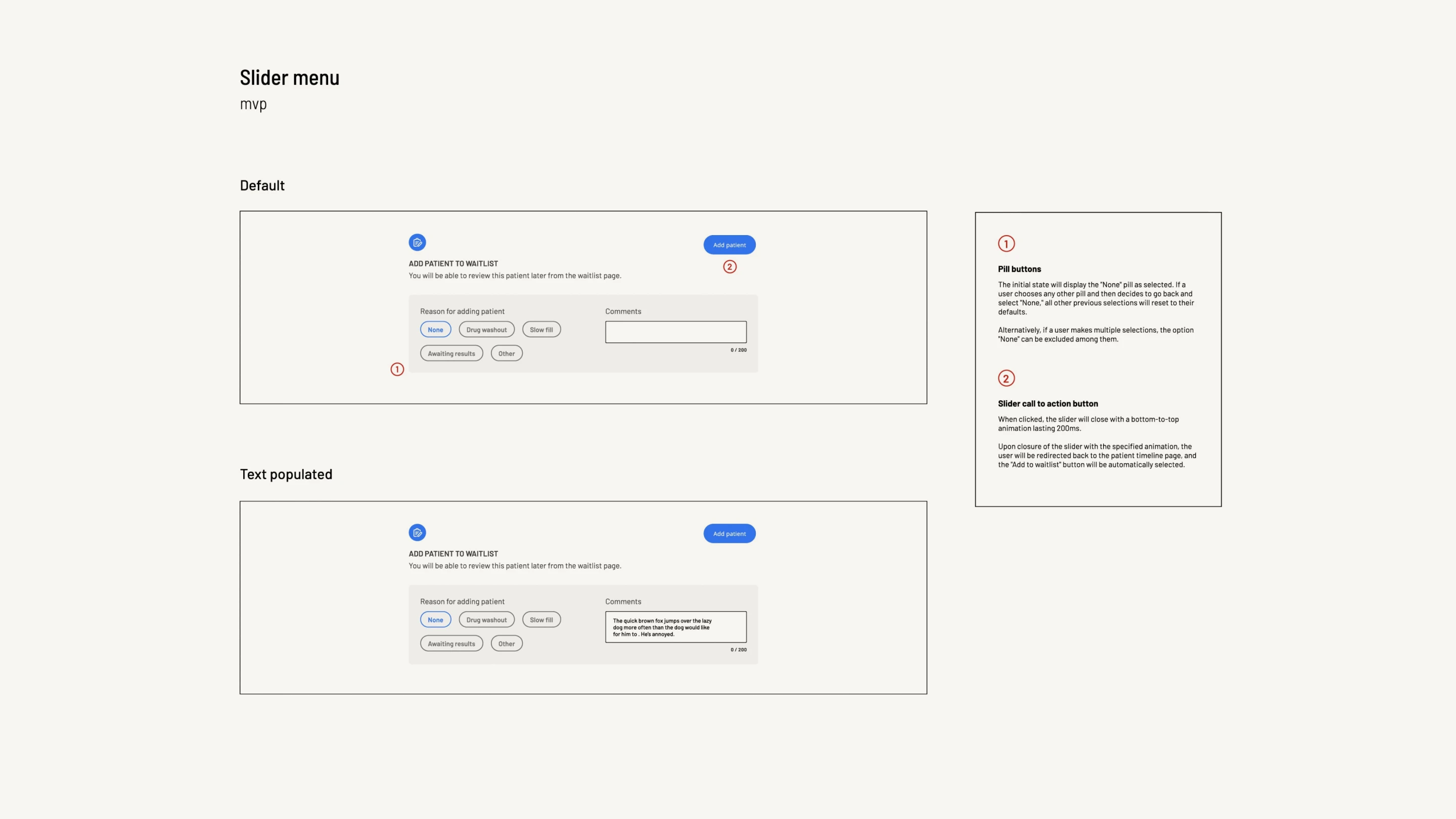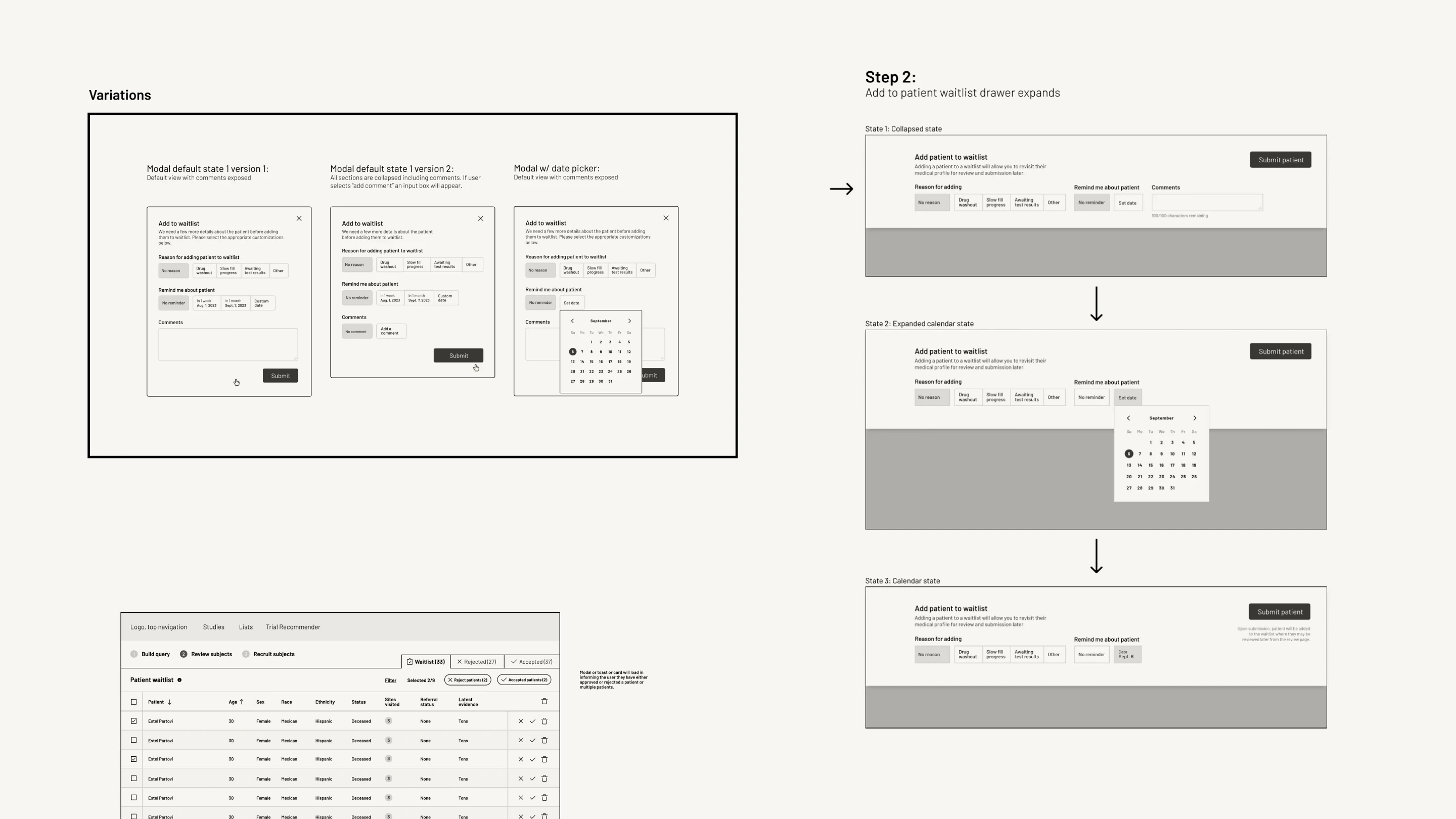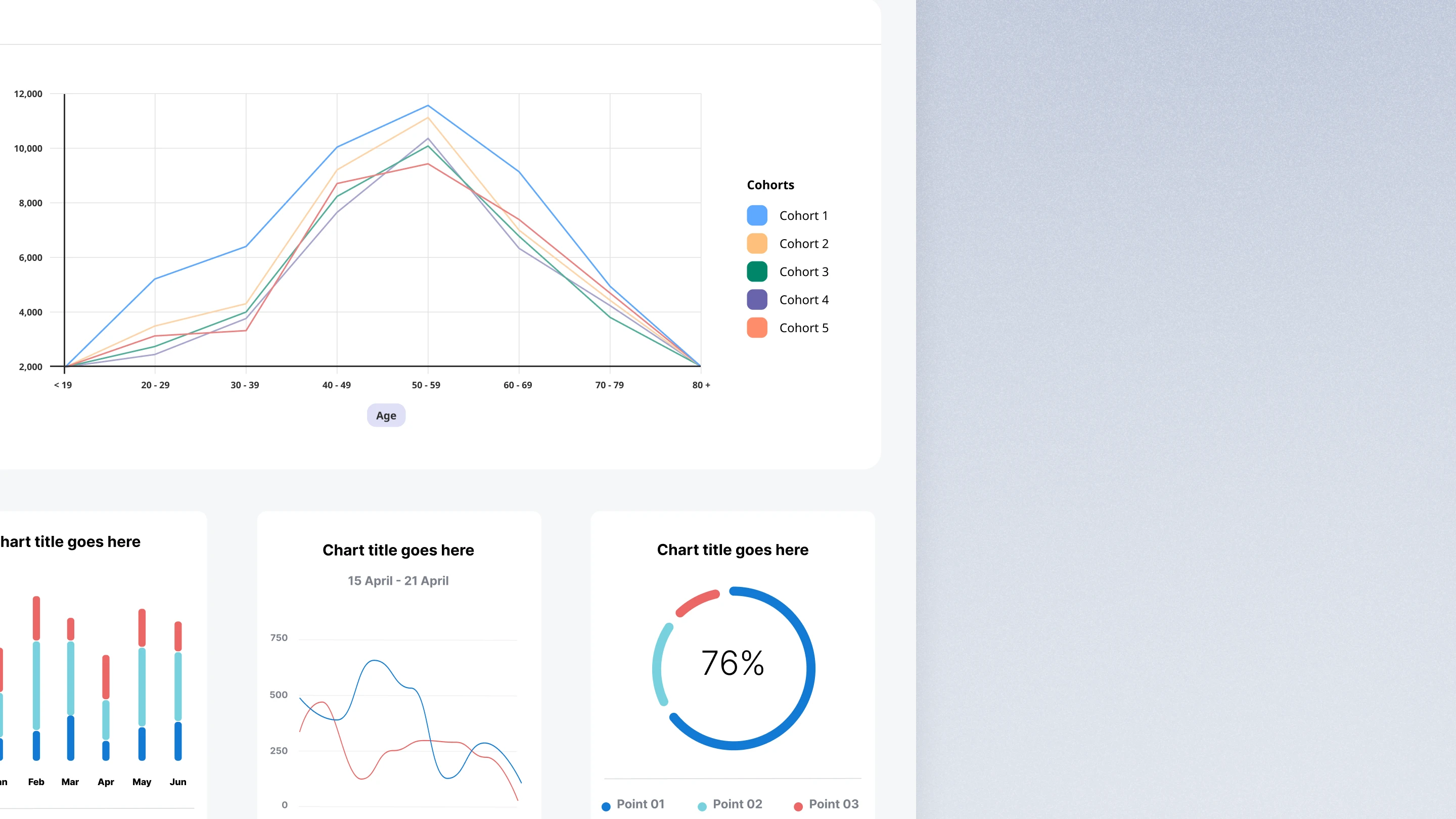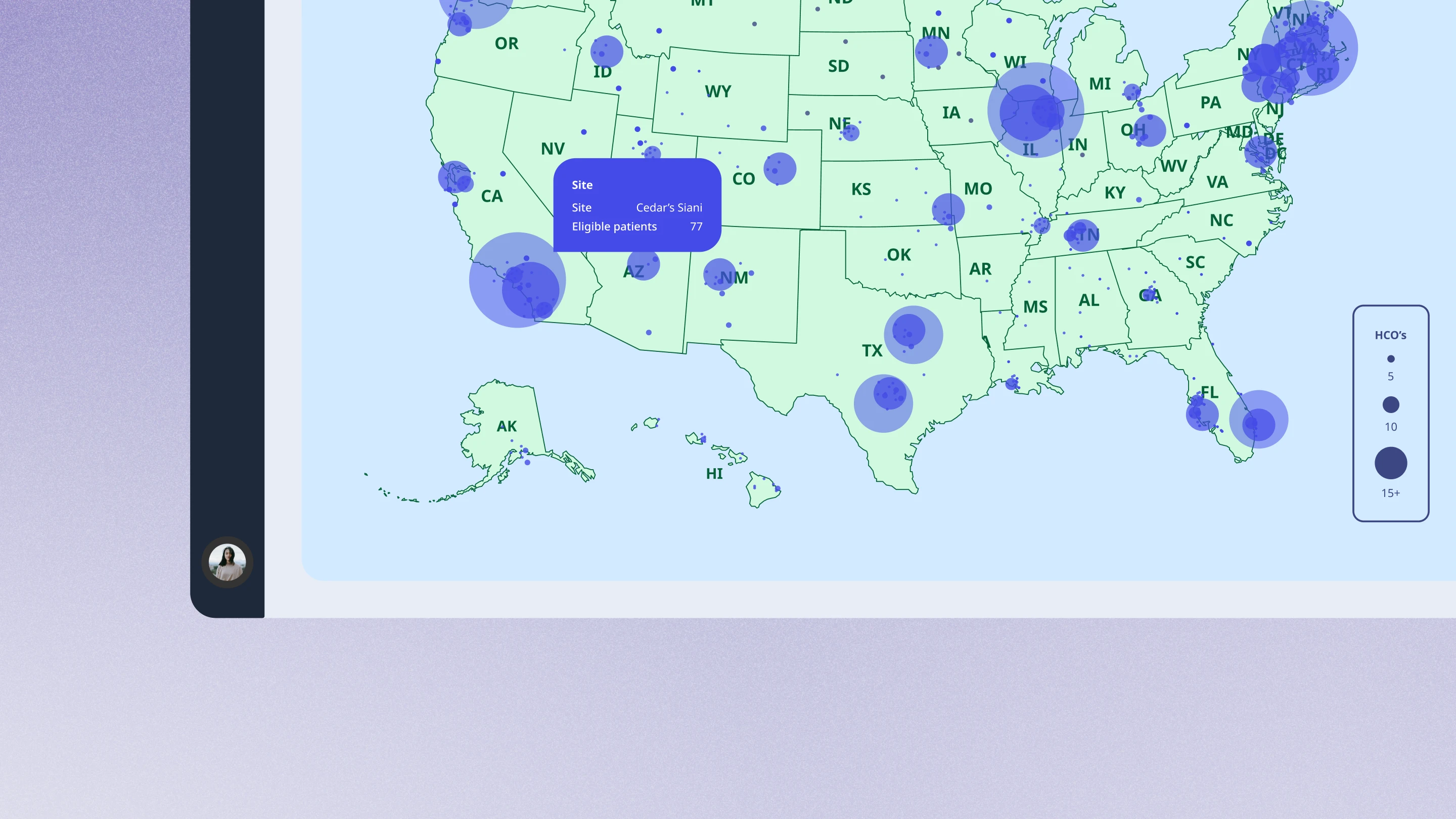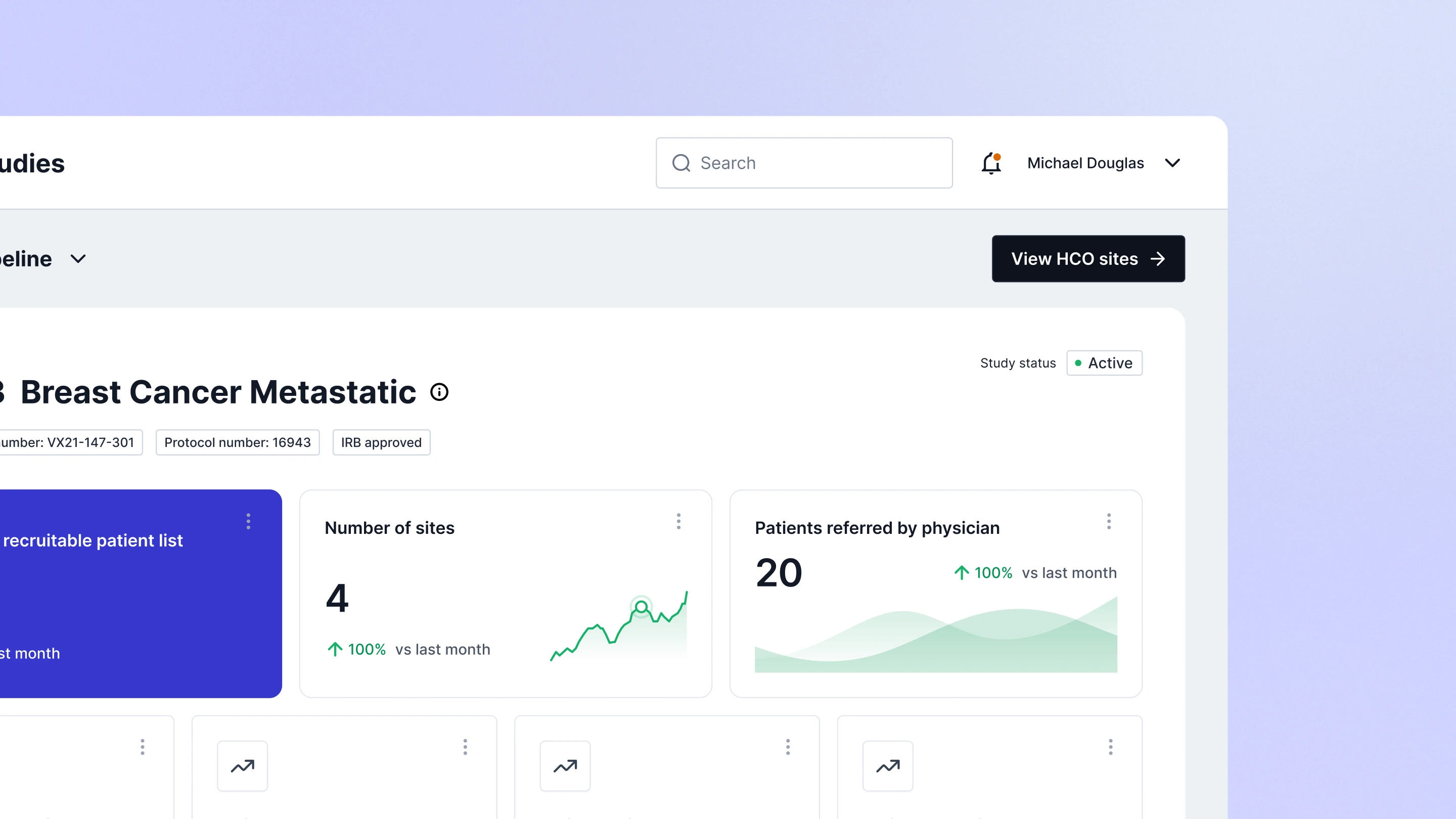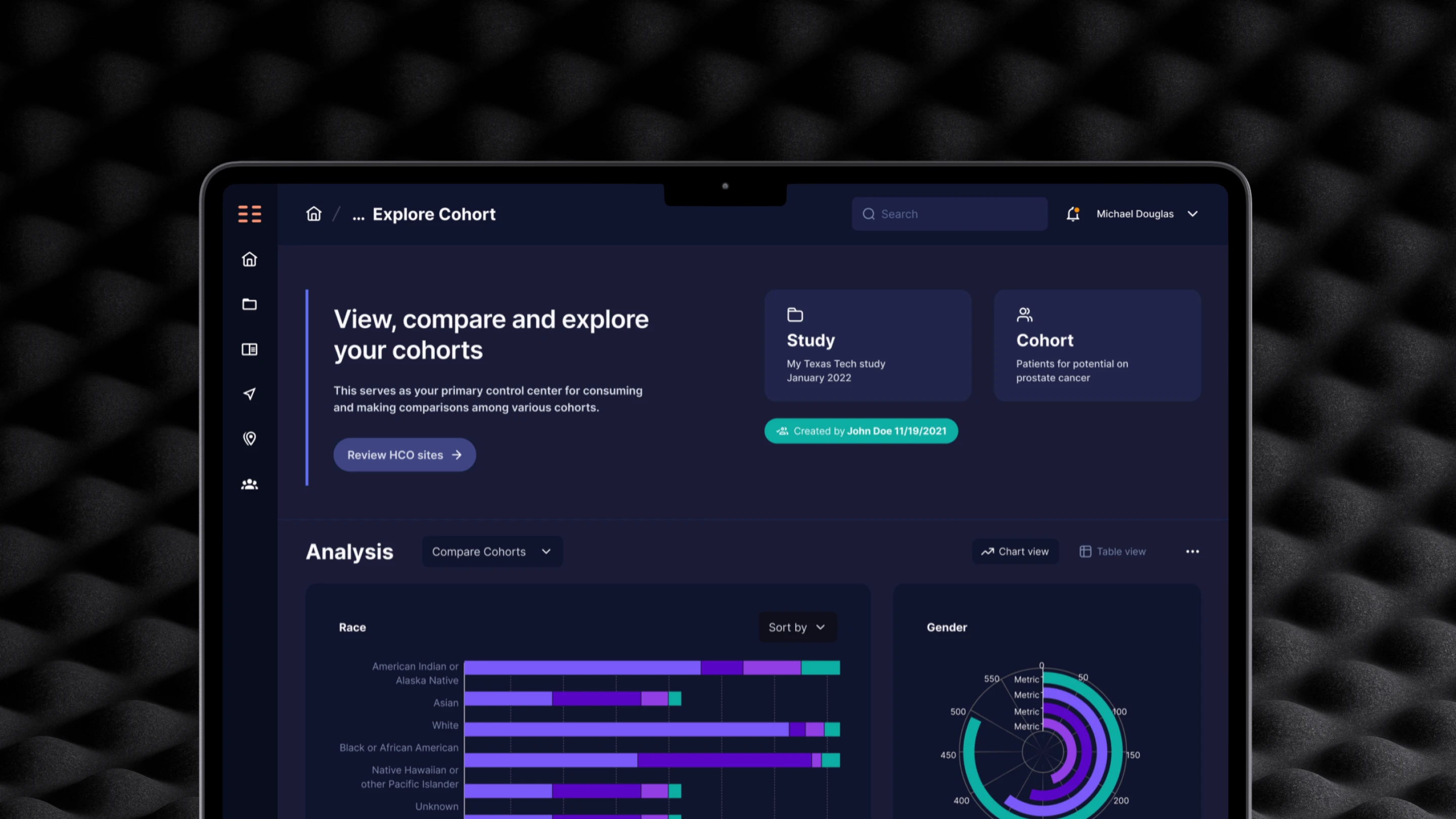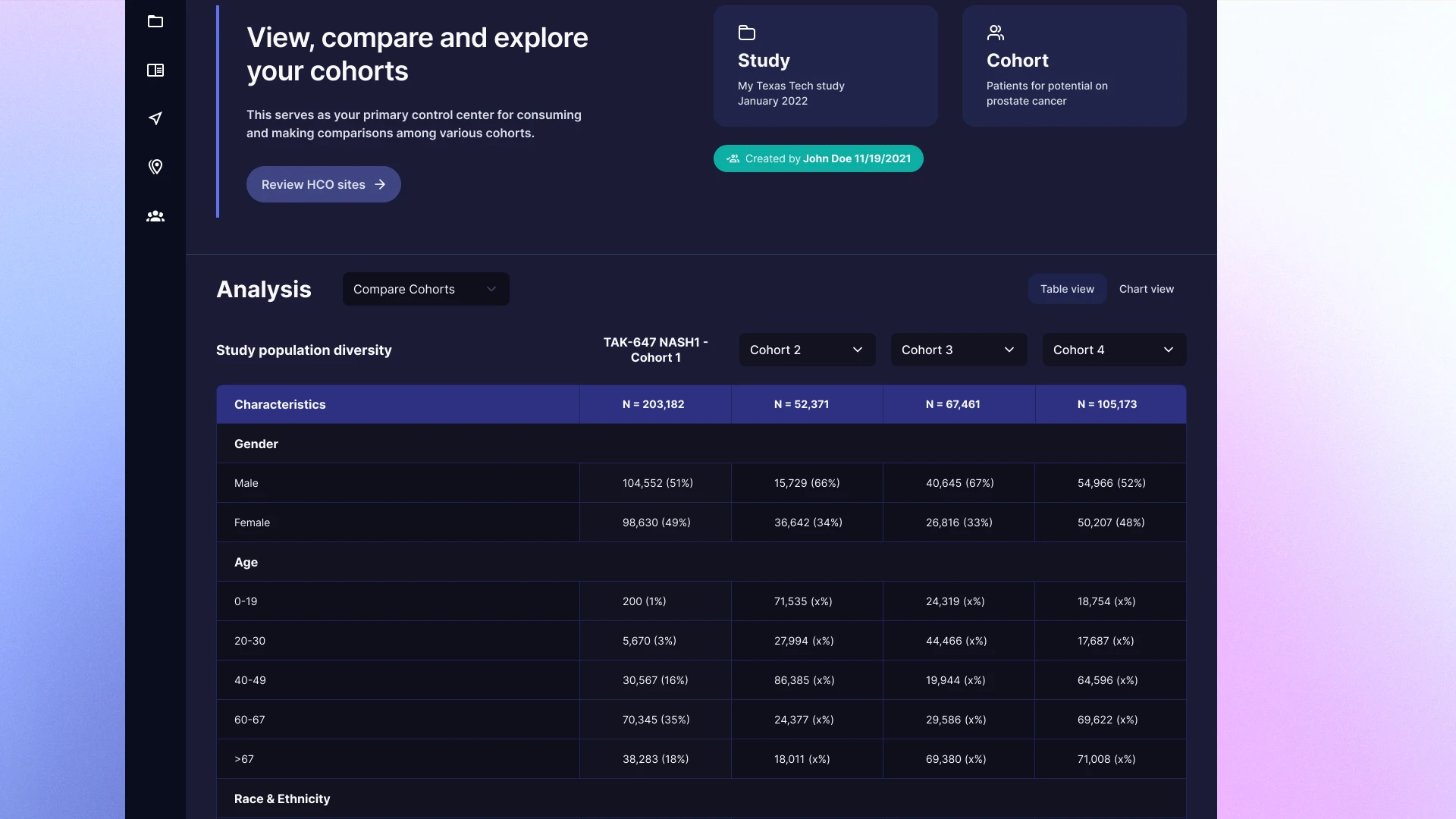



Lead UX Product Designer
Full time employee
2023-2024
SaaS
01
B2B
02
Design Systems
03
Product Design
04
Startup Culture
05
Overview
The goal was to simplify patient recruitment by creating an application that connected healthcare providers with suitable clinical trial candidates.
Objectives
Solutions
Centralized AI platform simplifies patient recruitment.
Feedback
Iterative design focused on usability and feedback.
Consistency
Collaborated with VP and CEO to define key features.
Engagement
Product progress generated interest in life sciences.
Research
Balanced user needs with advanced functionality.
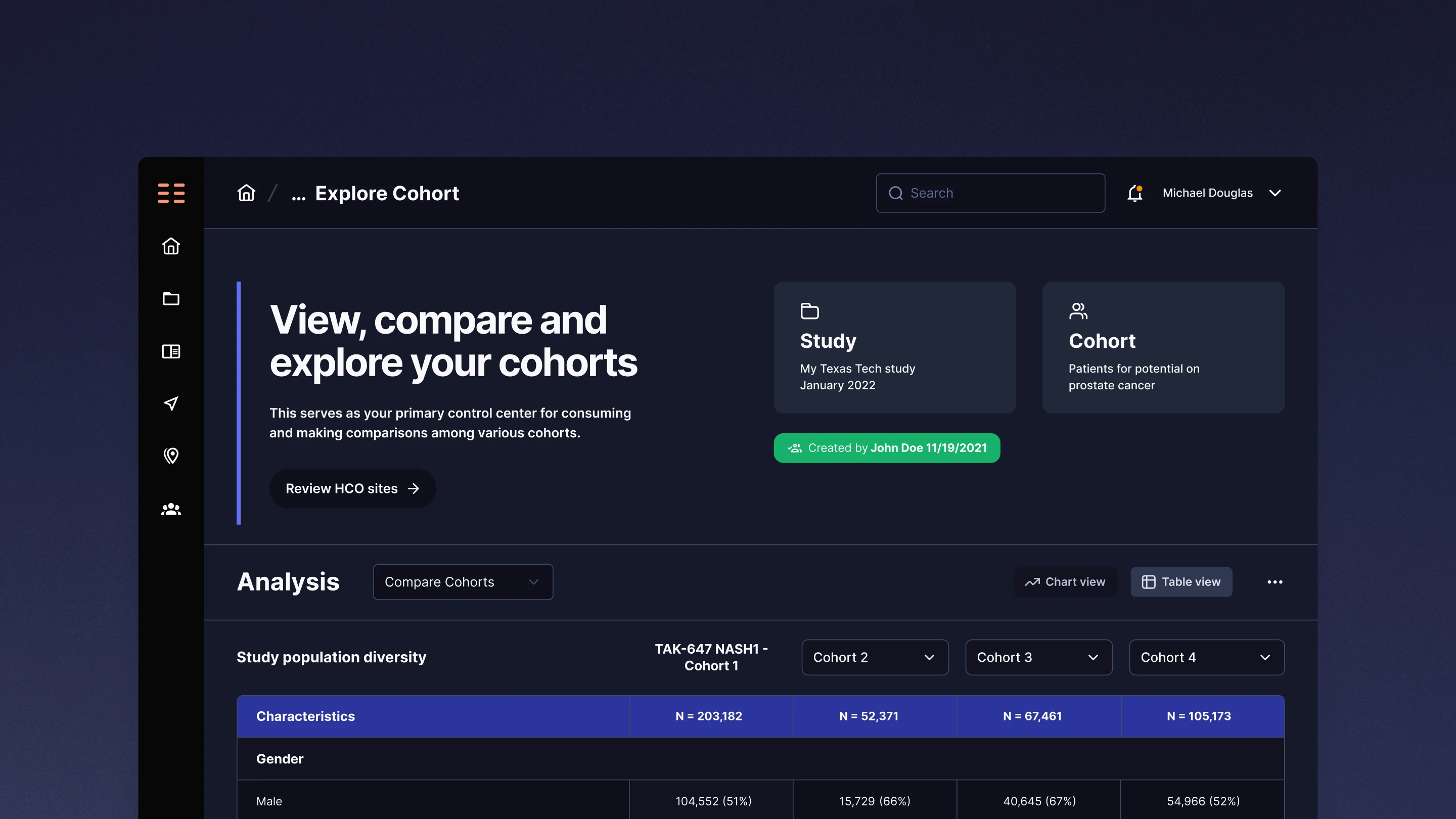


Enhancing patient recruitment
The goal was to simplify patient recruitment by creating an application that connected healthcare providers with suitable clinical trial candidates.
The Deep6 AI initiative sought to address the complexities of patient recruitment for clinical trials by creating a centralized application. This product was designed to link patients with suitable clinical trials and provide healthcare organizations with advanced tools for managing patient data.
Our goals included linking patients to appropriate trials, stratifying patient data based on various criteria, applying consistent UX/UI standards, and conducting user research to refine the product. The objective was to develop a solution that simplified complex data while meeting the needs of users in the life sciences field.
The project aimed to balance the intricacies of data management with user-friendly design, ensuring a product that was both powerful and accessible.
We knew patient recruitment for clinical trials was a bottleneck. Our goal was to build something that not only simplified the process but also provided powerful tools for healthcare organizations to manage patient data effectively.
Enhancing patient recruitment
The goal was to simplify patient recruitment by creating an application that connected healthcare providers with suitable clinical trial candidates.
The Deep6 AI initiative sought to address the complexities of patient recruitment for clinical trials by creating a centralized application. This product was designed to link patients with suitable clinical trials and provide healthcare organizations with advanced tools for managing patient data.
Our goals included linking patients to appropriate trials, stratifying patient data based on various criteria, applying consistent UX/UI standards, and conducting user research to refine the product. The objective was to develop a solution that simplified complex data while meeting the needs of users in the life sciences field.
The project aimed to balance the intricacies of data management with user-friendly design, ensuring a product that was both powerful and accessible.
We knew patient recruitment for clinical trials was a bottleneck. Our goal was to build something that not only simplified the process but also provided powerful tools for healthcare organizations to manage patient data effectively.
Enhancing patient recruitment
The goal was to simplify patient recruitment by creating an application that connected healthcare providers with suitable clinical trial candidates.
The Deep6 AI initiative sought to address the complexities of patient recruitment for clinical trials by creating a centralized application. This product was designed to link patients with suitable clinical trials and provide healthcare organizations with advanced tools for managing patient data.
Our goals included linking patients to appropriate trials, stratifying patient data based on various criteria, applying consistent UX/UI standards, and conducting user research to refine the product. The objective was to develop a solution that simplified complex data while meeting the needs of users in the life sciences field.
The project aimed to balance the intricacies of data management with user-friendly design, ensuring a product that was both powerful and accessible.
We knew patient recruitment for clinical trials was a bottleneck. Our goal was to build something that not only simplified the process but also provided powerful tools for healthcare organizations to manage patient data effectively.
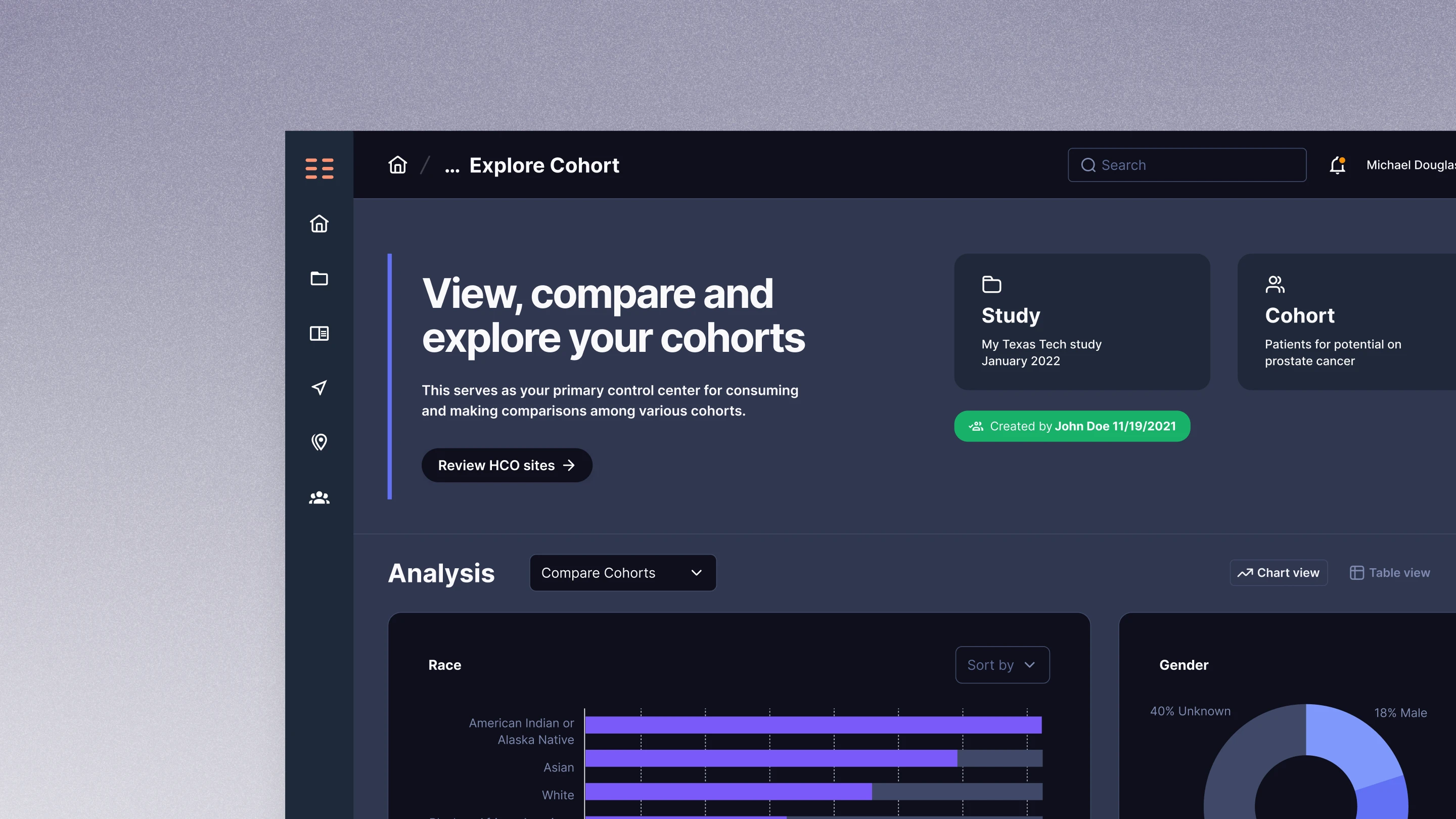


Simplifying complex data
My goal was to build a product that was simple yet had advanced functionality. I focused on evolving features and functionality depending on user needs.
My main objective was to address a complex healthcare issue by maintaining structured usability throughout the product. From the initial sign-in process to user cohort allocation, simplicity and ease of management were key priorities.
The product needed to handle intricate tasks related to clinical research coordinators and extensive user stratification data. This included designing features for viewing, sorting, filtering, and editing patient data, all while managing potentially thousands of records.
The application had two main views: one for detailed table data and another for geographic filtering of patients. The challenge was to deliver immediate simplicity that would evolve into more complex functionality as users engaged deeper with the product.
The challenge was making something complex feel simple. We needed to design an interface that could handle extensive patient data while being intuitive enough for users to navigate with ease.
Simplifying complex data
My goal was to build a product that was simple yet had advanced functionality. I focused on evolving features and functionality depending on user needs.
My main objective was to address a complex healthcare issue by maintaining structured usability throughout the product. From the initial sign-in process to user cohort allocation, simplicity and ease of management were key priorities.
The product needed to handle intricate tasks related to clinical research coordinators and extensive user stratification data. This included designing features for viewing, sorting, filtering, and editing patient data, all while managing potentially thousands of records.
The application had two main views: one for detailed table data and another for geographic filtering of patients. The challenge was to deliver immediate simplicity that would evolve into more complex functionality as users engaged deeper with the product.
The challenge was making something complex feel simple. We needed to design an interface that could handle extensive patient data while being intuitive enough for users to navigate with ease.
Simplifying complex data
My goal was to build a product that was simple yet had advanced functionality. I focused on evolving features and functionality depending on user needs.
My main objective was to address a complex healthcare issue by maintaining structured usability throughout the product. From the initial sign-in process to user cohort allocation, simplicity and ease of management were key priorities.
The product needed to handle intricate tasks related to clinical research coordinators and extensive user stratification data. This included designing features for viewing, sorting, filtering, and editing patient data, all while managing potentially thousands of records.
The application had two main views: one for detailed table data and another for geographic filtering of patients. The challenge was to deliver immediate simplicity that would evolve into more complex functionality as users engaged deeper with the product.
The challenge was making something complex feel simple. We needed to design an interface that could handle extensive patient data while being intuitive enough for users to navigate with ease.



Understand user needs
I worked with the VP of Product and CEO to gather user insights and define key features. This allowed us to find a clear path for what the product needed to be.
As the UX lead, my focus was on comprehending user needs and pain points within the life sciences sector. I collaborated closely with the VP of Product and CEO to gather requirements and establish feature priorities.
Research involved both qualitative and quantitative data to understand user requirements and data types. This collaboration with the product manager provided critical insights into the complexities of patient stratification.
Based on this research, I developed a detailed page-by-page flow for the product, guided by input from the CEO, VP, and select internal users. This process ensured that the design decisions were well-informed and aligned with user needs.
Collaborating with key stakeholders, we kept the user at the center of every decision. Each design iteration brought us closer to a solution that balanced functionality with usability.
Understand user needs
I worked with the VP of Product and CEO to gather user insights and define key features. This allowed us to find a clear path for what the product needed to be.
As the UX lead, my focus was on comprehending user needs and pain points within the life sciences sector. I collaborated closely with the VP of Product and CEO to gather requirements and establish feature priorities.
Research involved both qualitative and quantitative data to understand user requirements and data types. This collaboration with the product manager provided critical insights into the complexities of patient stratification.
Based on this research, I developed a detailed page-by-page flow for the product, guided by input from the CEO, VP, and select internal users. This process ensured that the design decisions were well-informed and aligned with user needs.
Collaborating with key stakeholders, we kept the user at the center of every decision. Each design iteration brought us closer to a solution that balanced functionality with usability.
Understand user needs
I worked with the VP of Product and CEO to gather user insights and define key features. This allowed us to find a clear path for what the product needed to be.
As the UX lead, my focus was on comprehending user needs and pain points within the life sciences sector. I collaborated closely with the VP of Product and CEO to gather requirements and establish feature priorities.
Research involved both qualitative and quantitative data to understand user requirements and data types. This collaboration with the product manager provided critical insights into the complexities of patient stratification.
Based on this research, I developed a detailed page-by-page flow for the product, guided by input from the CEO, VP, and select internal users. This process ensured that the design decisions were well-informed and aligned with user needs.
Collaborating with key stakeholders, we kept the user at the center of every decision. Each design iteration brought us closer to a solution that balanced functionality with usability.



Promising developments
The project showed promising progress, generating interest within the life sciences sector. While still in development, the focus on user-centered design demonstrated the application’s potential to revolutionize patient recruitment for clinical trials.
Significant progress has been made in developing the Life Sciences application, although it remains in progress. The product’s journey reflects the dynamic nature of startups, with other projects currently taking precedence.
Despite the ongoing development, the product has generated notable interest within the life sciences sector. The focus on user-centered design has showcased the potential impact of the application, indicating that it could greatly benefit clinical trial recruitment.
The final product is anticipated to make a substantial impact once completed, demonstrating the value of a well-designed solution in addressing complex healthcare challenges.
The feedback from the life sciences community has been encouraging. We’re confident that once completed, this application will have a significant impact on how patient recruitment is handled in clinical trials.
Promising developments
The project showed promising progress, generating interest within the life sciences sector. While still in development, the focus on user-centered design demonstrated the application’s potential to revolutionize patient recruitment for clinical trials.
Significant progress has been made in developing the Life Sciences application, although it remains in progress. The product’s journey reflects the dynamic nature of startups, with other projects currently taking precedence.
Despite the ongoing development, the product has generated notable interest within the life sciences sector. The focus on user-centered design has showcased the potential impact of the application, indicating that it could greatly benefit clinical trial recruitment.
The final product is anticipated to make a substantial impact once completed, demonstrating the value of a well-designed solution in addressing complex healthcare challenges.
The feedback from the life sciences community has been encouraging. We’re confident that once completed, this application will have a significant impact on how patient recruitment is handled in clinical trials.
Promising developments
The project showed promising progress, generating interest within the life sciences sector. While still in development, the focus on user-centered design demonstrated the application’s potential to revolutionize patient recruitment for clinical trials.
Significant progress has been made in developing the Life Sciences application, although it remains in progress. The product’s journey reflects the dynamic nature of startups, with other projects currently taking precedence.
Despite the ongoing development, the product has generated notable interest within the life sciences sector. The focus on user-centered design has showcased the potential impact of the application, indicating that it could greatly benefit clinical trial recruitment.
The final product is anticipated to make a substantial impact once completed, demonstrating the value of a well-designed solution in addressing complex healthcare challenges.
The feedback from the life sciences community has been encouraging. We’re confident that once completed, this application will have a significant impact on how patient recruitment is handled in clinical trials.
Progress & Insights
The project progress was tracked through regular updates and stakeholder feedback. Close collaboration with the VP of Product and CEO ensured alignment with project goals and user needs.
We monitored the development through iterative design and testing phases, gathering feedback to refine the product. Challenges included aligning stakeholder perspectives and managing scope creep, which impacted project timelines.
Despite these hurdles, the project demonstrated promising results and received significant interest from the life sciences community, highlighting the potential of user-centered design in specialized industries.
Progress & Insights
The project progress was tracked through regular updates and stakeholder feedback. Close collaboration with the VP of Product and CEO ensured alignment with project goals and user needs.
We monitored the development through iterative design and testing phases, gathering feedback to refine the product. Challenges included aligning stakeholder perspectives and managing scope creep, which impacted project timelines.
Despite these hurdles, the project demonstrated promising results and received significant interest from the life sciences community, highlighting the potential of user-centered design in specialized industries.
18
User research sessions
9
Design iterations
30+
Stakeholder meetings
4
Feature prioritization maps
4
Testing phases
2025
Project timeline
